The problems of creative management in TV-production
- Authors: Kemarskaya I.N.1
-
Affiliations:
- Academy of Media Industry
- Issue: Vol 29, No 1 (2024)
- Pages: 164-173
- Section: JOURNALISM
- URL: https://journals.rudn.ru/literary-criticism/article/view/40035
- DOI: https://doi.org/10.22363/2312-9220-2024-29-1-164-173
- EDN: https://elibrary.ru/KPMIOV
Cite item
Full Text
Abstract
The author, who has many years of practical experience of popular TV-programs creative producing, actualizes the problems of creative personnel management. The purpose of modern creative management assumes not only the integration of the media journalists’ convergent skills, but also the development of their creative abilities in original content development. Creativity is a semantically broad conception. By exploring empirical practice, the author identifies the most topical problems emphasizing the need of developing new approaches to creative management. The overabundance of definitions blurs the value criteria of post-industrial production of the screen shows. There is a collision of two aesthetic paradigms: innovative, Art Nouveau aesthetics, and “repetitive” postmodern aesthetics, proclaiming the creative value of variations. The method of variations demonstrates the author's individuality through predecessors' achievements, adapting other people's creative discoveries. Skills of “primary” and “secondary” creativeness represent a new type of media competencies. Interactive methods, gamification, multi-level brainstorming, discursive switching techniques make it possible to improve new criteria for media professionalism in the era of the upcoming creative economy.
About the authors
Irina N. Kemarskaya
Academy of Media Industry
Author for correspondence.
Email: kemarskaya2011@yandex.ru
ORCID iD: 0000-0001-7593-8042
Doctor of Philology, leading researcher at Research Sector
105 Oktyabrskaya St, bldg 2, Moscow, 127521, Russian FederationReferences
- Eco, U. (1996). Innovation and repetition. Between the aesthetics of modernity and postmodernity. In A. Usmanova (Ed.), Philosophy of the postmodern era: Collection of Translations and Abstracts (pp. 48–73). Minsk: Krasiko-Print. (In Russ.)
- Eglīte, Ž. (2023). Collaboration in creative industries – from creative individuals and intermedia- ries to networks. Culture Crossroads, 23, 102–117. https://doi.org/10.55877/cc.vol23.397
- Florida, R.L. (2012). The rise of the creative class: Revisited. New York: Basic Books.
- Gogatz, D., & Azavedo, M. (2023). Brainstorming: The need for professionalization of facilitators and participants. Journal of Business and Management Studies, 5(2), 72–82. https://doi.org/10.32996/jbms.2023.5.2.9
- Heath, R.G., & Stipp, H. (2011). The secret of television's success: emotional content or rational information? After fifty years the debate continues. Journal of Advertising Research, 51(1), 112–123. https://doi.org/10.2501/jar-51-1-112-123
- Ilyasova, E.V. (2017). The effort of being a journalist: the beginning of a creative workshop. RUDN Journal of Studies in Literature and Journalism, 22(4), 680–686. (In Russ.) https://doi.org/10.22363/2312-9220-2017-22-4-680-686
- Kemarskaya, I.N. (2022). Format dramaturgy of a television work in the media space of the digital age (abstract of Dr. Philol. Sci. Dis.). Moscow. (In Russ.)
- Knyazeva, E.N. (2023). Creative educational practices for sustainable futures. Philosophy. Journal of the Higher School of Economics, 7(3), 129–151. (In Russ.) https://doi.org/10.17323/2587-8719-2023-3-129-151
- Krivovyaz, N.V., & Ryabchenko, D.O. (2021). On the nature of the “cultural shift” in the value system of the creative class in a prosperous society. Journal of Wellbeing Technologies, 42(3), 66–74. (In Russ.) https://doi.org/10.18799/26584956/2021/3(42)/1079
- Krylov, V.K. (2022). Discursive and methodological limitations of research on the management of creative processes. Society: Philosophy, History, Culture, (6), 100–103. (In Russ.) https://doi.org/10.24158/fik.2022.6.17
- Maslow, A.H. (1954). Motivation and personality. New York: Harper.
- McLoone, M. (1996). Boxed in? The aesthetics of film and television. In J. Hill & M. McLoone (Eds.), Big Picture, Small Screen: The Relations Between Film and Television (pp. 76–106). Luton: University of Luton Press.
- Nikolaeva, O.V., & Kokhan, I.N. (2022). Chronicle of the conference “Linguistic and discursive creativity of the speaker. The modern world in the languages of Russia, East and West”. Communication Studies, 9(2), 429–438. (In Russ.)
- Panova, E.Yu. (2017). Creativity in professional journalistic education: challenges vs standards. Bulletin of the Chelyabinsk State University. Philology Sciences, 109(11), 43–47. (In Russ.)
- Rybak, E.V. (2022). Creative group as a technology for professional development of students of a pedagogical college and kindergarten teachers. Humanitarian and Pedagogical Education, 8(S1), 230–234. (In Russ.)
- Simonton, D.K. (1997). Genius and creativity: Selected papers. New York: Bloomsbury Academic.
- Urazova, S.L. (Ed.). (2021). Media ecosystem: Digital modifications. Chelyabinsk: SUSU Publ. (In Russ.)
- Widman, M. (2003). Film & TV: Aesthetic interaction. Paper presented at Society for Cinema and Media Studies. Minneapolis: Lund University.
- Zvereva, E.A. (2019). Form deviations journalist’s professional activity: constructive and destructive practices. Media Research, 6, 342–349. (In Russ.)
















